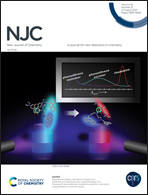Novel PET-pperated rosamine pH-sensor dyes with substitution pattern-tunable pKa values and temperature sensitivity†
Abstract
We present the synthesis and characterization of a family of regioisomerically pure pH-sensitive rosamine fluorophores consisting of xanthene fluorophore cores, which determine the dyes’ photophysical properties such as excitation/emission wavelength, fluorescence quantum yield, and fluorescence lifetime, and differently substituted phenol moieties. The hydroxyl substituent of the phenol moiety introduces a pH sensitivity of the dyes’ fluorescence exploiting a photoinduced electron transfer (PET), that leads to a protonation-induced switching ON of the rosamine emission. Rational tuning of the pKa value of the rosamine fluorescence between 4 to 9 is achieved by altering the substitution pattern and degree of bromination of the phenolic subunits. Additionally, a temperature sensitivity of the fluorescence quantum yield is introduced or suppressed based upon the degree of rigidity of the xanthene scaffold.



 Please wait while we load your content...
Please wait while we load your content...